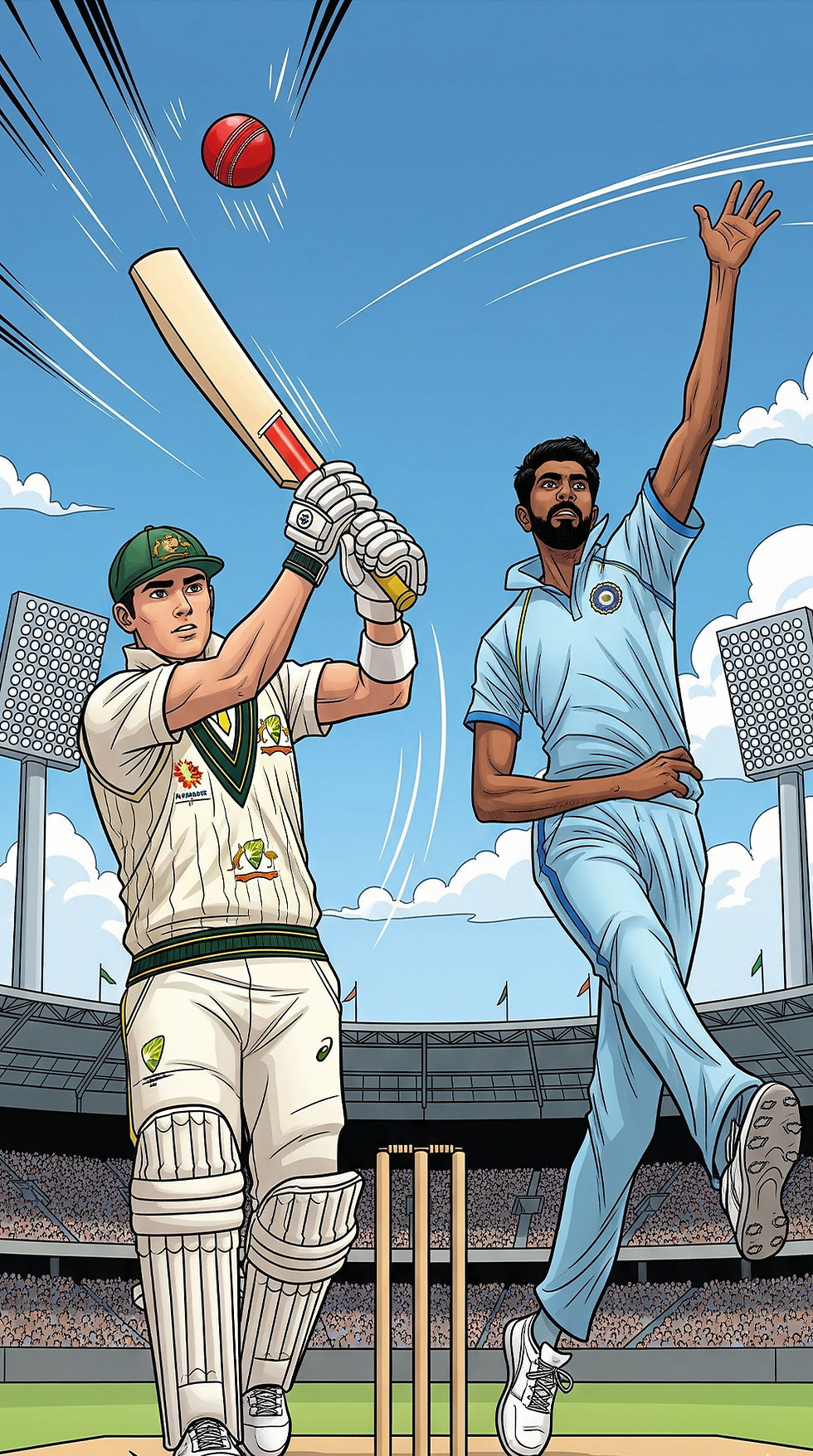The Five-Day Epic: Why Test Cricket is Sporting Theatre
- DRNKN WZRD

- Sep 1
- 4 min read
Updated: Sep 2

You might catch a glimpse of a Test match on a TV screen. A batsman defends, the ball thuds safely into the keeper's gloves, and the commentary is a low, almost meditative hum. To the uninitiated, it might seem… boring. But to those of us who truly understand, this isn't merely sport; it's a five-day epic, a meticulously crafted theatrical production unfolding before our very eyes.
It’s a play with a cast of dozens, a dynamic stage, and a script rewritten with every delivery. And for sheer narrative engagement, Test cricket stands head and shoulders above all other sporting spectacles.
Act I: The Overture and The Grand Opening
The drama of a Test match doesn't start with the first ball; it begins months, even a year, beforehand. This is our Overture, played out in the media cycle. Pundits on TV, journalists in print, and passionate fans across social media dissect every rumour. Who will open the batting for Australia during the Ashes? Should Ollie Pope be in the squad? The speculation around selections, the predictions, and the repeating of old cliches all rev up the buzz, creating characters and storylines long before they ever step onto the stage.
Cricket fans join F1 ones in checking the weather and praying to the weather gods. Old legends of the game talk us through the pitch report with 0% accuracy. Then comes the Toss. This isn't just a coin flip; it’s the moment the curtain rises, and the captains make their first critical strategic decision. Will they bat on a fresh, untrodden pitch, or unleash their bowlers under an overcast sky? This single, random event can dictate the entire narrative arc of the next five days, and beyond. It’s a moment of pure, unadulterated tension, where the flip of a coin can seal a team's fate.
And then, the First Ball. The moment an entire arena holds its breath as a nation's quickest bowler charges in. It's the dramatic opening line of our play, a statement of intent that sets the tone for the entire series. Remember Mitchell Starc to Rory Burns in the 2021-22 Ashes? Or, in the last Ashes, Zak Crawley driving the first ball for four down the ground, a defiant roar from England's 'Bazball' revolution. These aren't just deliveries; they are our first glimpse of what is about to unfold—a confirmation of a captain's gut feeling or a sudden twist in the plot. They instantly define the conflict of the drama.
Act II: The Rising Action
As the match progresses, we enter the Rising Action. This is where the beauty of Test cricket’s pacing pays dividends. Every individual battle, each little mini-drama that plays out in front of us, draws a new noise from the stands. Each block, drive, and play-and-miss shifts the dial in the constant, ebbing and flowing power struggle between batter and bowler.
Think back to the Boxing Day Test in 2024. Australia bats first at the MCG, and 18-year-old Sam Konstas faces up against Bumrah. This battle had my younger brother hooked. He was about to head to bed, but stayed until the first drinks break, enthralled by the spectacle. When Kohli barged him, my brother leapt out of his seat with a roar, fully invested in the drama of the moment—a complete transformation for someone who had zero interest just minutes before.
The commentators act as our narrators. They dissect the action, the psychology of the battle, and offer crucial insight. They keep the story moving and the match engaging, providing additional context, anecdotes, and entertainment. The pacing allows a more impactful story to be told and provides a much more cohesive viewing experience.
The audience, often full of people hoping for a good time with a few drinks, can suddenly become an added layer of tension. The moment the drama shifts and the tension rises, the crowd falls silent, fully invested in every single delivery.
Act III: The Climaxes and Unexpected Twists
All that earlier build-up, laying the foundations and setting the narrative, becomes more important as the game goes on. This is where Test cricket truly shines as a theatrical experience, delivering climaxes and turning points that few other sports can match. The five-day format allows for the most incredible, unscripted plot twists.
The ability for heroics is similar to those of folklore. Think of Ben Stokes at Headingley in 2019, somehow pulling off one of the greatest individual heists in sport. The crowd, coming in expecting disappointment, had the faintest hope just due to Ben Stokes’ presence. That hope grew ball by ball, moment by moment. Australia, having been wasteful with earlier reviews, lost their chance to dismiss him when he was plumb. But with no reviews and a no-call from the umpire, it begins to feel fated. Then Nathan Lyon misses a run-out opportunity that seals this moment as destiny. The ultimate drama. Tales of it will be told for years to come—a moment of folklore in the making.
Act IV: The Denouement and The Final Bow
As the final act draws to a close, the tension is almost unbearable. Whether it's a desperate number 10 and 11 batting to save the match on Day 5, denying their opponents victory through sheer defiance, or a fast bowler steaming in for the winning wicket in the dying overs, the denouement is riveting. The clock becomes a character, and the fading light a dramatic prop.
When it's all over, the players line up for their final bow. They shake hands, the victors celebrate, the defeated reflect but the performance doesn't truly end here as it etches it’s way into history, to be retold as legendary tales adding to the lore making future series that bit more meaningful.
Test cricket, with its long form, its evolving conditions, its narrative depth, and its capacity for in-depth analysis and unscripted storytelling, isn't just a game. It's a five-day theatrical masterpiece, where every session is an act, every delivery a line, and every match an unforgettable drama. You don't just remember the score; you remember the feeling.





Comments